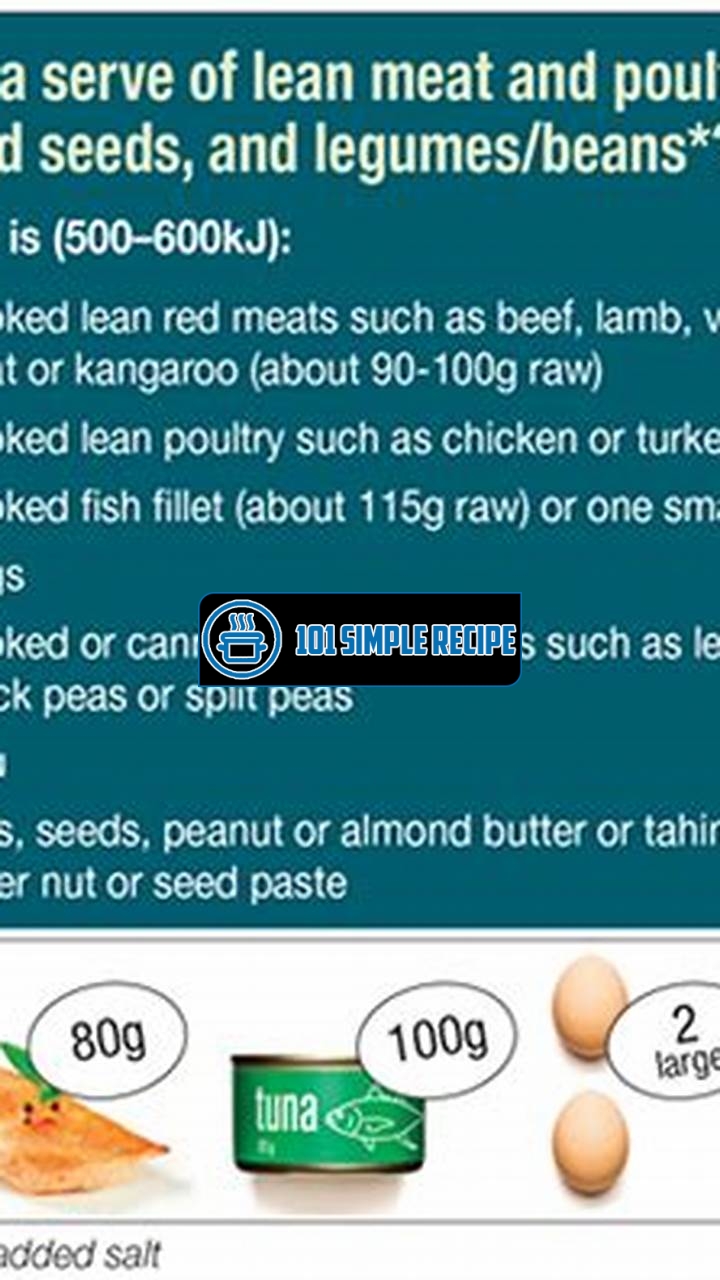Are you unsure about how much chicken to serve for your next meal? Determining the perfect serving size of chicken can be a challenge, but don’t worry, we’ve got you covered! In this article, we will provide you with essential tips and tricks to help you determine the ideal portion of chicken for a satisfying and balanced meal. Whether you’re cooking for yourself, your family, or a gathering of friends, knowing the right amount of chicken to prepare is crucial for both taste and nutrition. So, let’s dive in and discover how to serve up the perfect portion of this versatile poultry! ️

Understanding the Concept of a Serving Size
In order to determine the perfect serving size of chicken, it is important to first understand the concept of a serving size. Serving sizes are standard measurements of food that are used to indicate a recommended portion size for a particular food item. These measurements are determined by nutrition experts and are designed to help individuals make informed decisions about their food intake. Serving sizes are typically expressed in common household measurements such as cups, tablespoons, or pieces, and they vary depending on the type of food being served.
When it comes to chicken, serving sizes can be a bit tricky to determine. They can vary depending on the cut of the chicken, the cooking method, and the desired meal size. For example, a serving size for grilled chicken breast may be different than that for fried chicken wings. Additionally, the serving size may also be influenced by factors such as the individual’s age, sex, activity level, and overall health goals.
What is a Serving Size?
A serving size of chicken refers to the recommended portion size for this particular protein. It is important to remember that the serving size is not necessarily the amount of chicken that you should consume in one sitting; rather, it is a standard measurement that serves as a guideline for portion control. The serving size for chicken is typically measured in ounces or grams.
For example, a typical serving size of boneless, skinless chicken breast is about 3 ounces or 85 grams. This means that if you were measuring your chicken breast, it should ideally weigh around 3 ounces before cooking.
Understanding the serving size is important because it helps you manage your overall calorie and nutrient intake. By knowing the recommended portion size, you can make more informed choices about your plate composition and ensure that you are getting the right amount of nutrients without overindulging in food.
Factors Affecting Serving Sizes
Several factors can influence the serving sizes of chicken. These factors include the cooking method, the desired meal size, and the specific cut of the chicken. For instance, a serving size of grilled chicken breast may be larger than that of fried chicken wings due to the differences in the cooking method and the amount of fat added during the cooking process.
Other factors that can affect serving sizes include individual dietary needs and goals. If you are trying to lose weight or maintain a certain calorie intake, you may choose to have a smaller serving size. On the other hand, if you have higher energy requirements or are engaging in strenuous physical activity, you may opt for a larger serving size to meet your nutritional needs.
Importance of Knowing Serving Sizes
Knowing the serving sizes of chicken is important for several reasons. Firstly, it helps you maintain a balanced and nutritious diet. By understanding the recommended portion sizes, you can ensure that you are consuming the right amount of protein, vitamins, and minerals that are essential for your overall well-being.
Secondly, knowing the serving sizes can aid in portion control. It can prevent overeating and help you manage your caloric intake. By sticking to the recommended portion sizes, you can maintain a healthy weight and reduce the risk of chronic diseases associated with excessive calorie consumption.
Lastly, understanding serving sizes allows you to make more accurate calculations and adjustments when planning meals or following recipes. It helps you determine the appropriate amount of ingredients needed and ensures that you are consuming a balanced meal.
In conclusion, understanding the concept of a serving size is crucial for determining the perfect serving size of chicken. By considering factors such as the cooking method, desired meal size, and individual dietary needs, you can make informed decisions about portion control and ensure that you are consuming the recommended amount of chicken to support your overall health and well-being.
Guidelines for Chicken Serving Sizes
When it comes to determining the perfect serving size of chicken, it is important to consider the recommendations for different cuts of chicken and the nutritional significance they offer. Whether you are grilling chicken breasts, cooking chicken thighs, or roasting a whole chicken, understanding the appropriate serving sizes will help you plan your meals and ensure you are getting the right amount of protein and nutrients.
Serving Sizes for Chicken Breasts
Chicken breasts are a popular choice due to their lean protein content and versatility in various recipes. A typical serving size for chicken breasts is about 3 ounces or approximately the size of a deck of cards. This portion provides around 165-180 calories and 19-21 grams of protein. It is important to note that the nutritional content may vary depending on the preparation method and any additional ingredients used.
To determine the perfect serving size of chicken breasts, consider your individual dietary needs and activity level. If you are aiming for weight loss or watching your calorie intake, you may choose to have a smaller portion size. On the other hand, if you have higher energy requirements or engage in intense physical activity, you may opt for a slightly larger serving size.
When cooking chicken breasts, it is advisable to trim any visible fat before preparation to reduce the overall calorie and fat content. Seasonings and marinades can add flavor without significantly altering the serving size. Just make sure to account for any additional calories or sodium content from these ingredients.
Serving Sizes for Chicken Thighs
Chicken thighs are known for their rich flavor and tenderness. The recommended serving size for chicken thighs is generally about 3-4 ounces or the size of a palm. This portion provides approximately 200-240 calories and 19-23 grams of protein.
Keep in mind that chicken thighs have a slightly higher fat content compared to chicken breasts. While they offer a flavorful experience, it is essential to moderate your portion size if you are watching your fat intake or trying to maintain a balanced diet.
If you prefer crispy chicken thighs, consider removing the skin before cooking to reduce the overall calorie and fat content. However, if you enjoy the crispy texture, you can indulge in the skin occasionally but in moderation.
Serving Sizes for Whole Chicken
Enjoying a whole roasted chicken can be a delightful meal for a family dinner or special occasion. The serving size for a whole chicken is typically 3-4 ounces per person. This generous portion provides approximately 240-280 calories and 18-23 grams of protein.
When cooking a whole chicken, it is essential to ensure it reaches the proper internal temperature to ensure food safety. The USDA recommends cooking chicken to a minimum internal temperature of 165°F (74°C) to eliminate any harmful bacteria.
To determine the appropriate serving size for a whole chicken, consider the number of people you are serving and any other accompaniments in the meal. If you have leftovers, you can store them in the refrigerator for a delicious chicken salad or use the meat in other recipes throughout the week.
Nutritional Significance
Chicken is not only a good source of lean protein but also contains essential vitamins and minerals such as vitamin B6, niacin, selenium, and phosphorus. It is a complete protein source, which means it provides all the essential amino acids our bodies need.
Additionally, chicken is low in saturated fat compared to other animal protein sources like red meat. Including chicken in your diet can contribute to overall heart health and help in maintaining a healthy weight.
Remember that these serving sizes are general guidelines and can vary depending on different factors such as individual dietary needs, activity levels, and health goals. It is always recommended to consult with a healthcare professional or registered dietitian to determine the appropriate serving size for your specific needs.
If you’re looking for a delicious chicken dish, you might want to try this garlic cream sauce recipe. It pairs well with chicken and can be a tasty addition to your meal.
Understanding the Nutritional Value of Chicken
When it comes to determining the perfect serving size of chicken, it’s important to have a good understanding of its nutritional value. Chicken is not only delicious but also a great source of essential nutrients that contribute to a healthy diet.
Protein Content in Chicken
One of the main reasons why chicken is a popular choice among health-conscious individuals is its high protein content. Protein plays a crucial role in building and repairing tissues, supporting immune function, and maintaining healthy skin, hair, and nails.
Chicken is an excellent source of complete protein, which means it contains all the essential amino acids that your body needs. In fact, one serving of chicken can provide around 25 grams of protein, making it an ideal choice for meeting your daily protein requirements.
Tip: Include chicken in your meals to meet your protein needs and promote muscle growth and repair. Pair it with vegetables and whole grains for a well-rounded and nutritious meal.
Key Vitamins and Minerals in Chicken
In addition to its protein content, chicken is also rich in essential vitamins and minerals that are vital for overall health and well-being.
Vitamin B6, also known as pyridoxine, is found in abundance in chicken. This vitamin is essential for brain development and function, as well as the production of red blood cells.
Chicken is also a good source of niacin, a B-vitamin that helps convert food into energy and contributes to a healthy digestive system. Additionally, it contains phosphorus, which is important for maintaining strong bones and teeth.
Tip: Incorporate chicken into your diet to ensure you’re getting an adequate intake of essential vitamins and minerals that support various bodily functions.
Fat Content in Chicken
When it comes to determining the perfect serving size of chicken, it’s important to consider its fat content. While chicken is generally a lean protein, the fat content can vary depending on the cut and cooking method.
Skinless, boneless chicken breasts are the leanest option, containing minimal amounts of fat. On the other hand, darker meat cuts like chicken thighs and drumsticks tend to have slightly higher fat content.
The way you cook chicken also affects its fat content. Grilling, baking, or steaming chicken can help minimize the fat content, while frying or deep-frying chicken can significantly increase its fat content.
Tip: Opt for lean cuts of chicken and choose healthier cooking methods to minimize the fat content and make it a nutritious addition to your meals.
In conclusion, understanding the nutritional value of chicken is essential for determining the perfect serving size. With its high protein content, essential vitamins and minerals, and varying fat content, chicken can be a healthy and versatile option for your meals. Incorporate chicken into your diet to reap its numerous health benefits and enjoy its delicious taste.
To learn more about chicken and its serving size, you can check out this recipe for peanut butter cups. This recipe can give you an idea of how to use chicken as an ingredient and the portion size you can expect.
Factors Influencing Optimal Chicken Serving Sizes
When it comes to determining the perfect serving size of chicken, several factors come into play. These factors can vary from individual to individual and can greatly affect the ideal portion size. By understanding these factors, you can make more informed decisions about how much chicken to serve yourself or others. Let’s explore the main factors that influence optimal chicken serving sizes:
Dietary Needs and Goals
Your dietary needs and goals play a significant role in determining the perfect serving size of chicken. Whether you are following a specific diet plan or have certain nutritional requirements, it is essential to consider these factors when deciding on your chicken portion. For example, if you are following a low-calorie diet, you may opt for a smaller serving size to control your calorie intake. On the other hand, if you are aiming to build muscle or require a higher protein intake, you might choose a larger serving size. Evaluating your dietary needs and goals is crucial to determining the appropriate portion of chicken.
Physical Activity Levels
How physically active you are on a daily basis is another important factor to consider when determining chicken serving sizes. If you lead a sedentary lifestyle and engage in minimal physical activity, you may require smaller portions of chicken to maintain a healthy weight. Conversely, if you have an active lifestyle or engage in regular exercise, you may need larger servings of chicken to support muscle recovery and growth. Adjusting your chicken portion based on your physical activity levels can ensure you meet your energy needs.
Personal Preferences and Food Choices
Your personal preferences and food choices also play a vital role in determining the perfect serving size of chicken. Some individuals may have a preference for larger portion sizes, while others may prefer smaller, more frequent meals. It is essential to consider your personal preferences and listen to your body’s hunger and fullness cues when deciding on your chicken portion. Additionally, if you complement your chicken with side dishes or incorporate it into recipes, consider the overall composition of your meal to maintain portion control and balanced nutrition. Finding the right balance between personal preferences and nutritional needs is key to determining your ideal serving size.
In conclusion, determining the perfect serving size of chicken involves considering several factors such as dietary needs and goals, physical activity levels, and personal preferences and food choices. By evaluating these factors and making informed decisions, you can ensure you are consuming the appropriate portion of chicken that aligns with your nutritional requirements and goals.
If you’re in the mood for a classic chicken recipe, you can try making teriyaki chicken. This recipe will give you a flavorful chicken dish with a delicious sauce.
Tips for Accurately Measuring Chicken Servings
When it comes to determining the perfect serving size of chicken, there are a few tips and tricks you can use to ensure you are consuming the right amount. Whether you’re using a kitchen scale, visual references for portion control, or dealing with restaurant and takeout meals, here are some methods and tools you can employ.
Using a Kitchen Scale
One of the most accurate ways to measure your chicken servings is by using a kitchen scale. This tool allows you to measure the weight of your chicken precisely, ensuring you stay within the recommended serving size. To use a kitchen scale, follow these steps:
- Place a clean plate or bowl on the kitchen scale.
- Tare the scale to set it to zero.
- Add the chicken to the plate or bowl.
- Read the weight displayed on the scale.
By using a kitchen scale, you can easily determine the appropriate serving size based on weight. Remember to adjust for bone-in or boneless chicken, as the weight may vary.
Visual References for Portion Control
If you don’t have access to a kitchen scale, visual references can help you estimate your chicken servings. Here are some handy visual references:
- A deck of cards or the palm of your hand: A serving of chicken should be about the size of a deck of cards or the palm of your hand. This can give you a rough idea of how much chicken to consume.
- A smartphone: Another visual reference is a smartphone. The thickness and size of your smartphone can be a helpful guide when it comes to portion control.
Using these visual references canassist you in determining a suitable serving size of chicken without the need for a scale. However, keep in mind that individual hand sizes and smartphones may vary, so it’s best to use these references as a general guideline.
Tips for Restaurant and Takeout Meals
When dining out or ordering takeout, it can be challenging to accurately measure your chicken servings. However, you can still make informed choices with these tips:
- Share a meal: Consider sharing a chicken dish with someone else to reduce your portion size.
- Ask for half your meal to be packed to go: If the portion served is larger than what you need, request to have half of it packed to take home. This allows you to control your intake and enjoy the rest later.
- Request a smaller portion: Some restaurants offer options for smaller portion sizes. Don’t hesitate to ask for a reduced serving of chicken if available.
By practicing these tips, you can maintain portion control even when eating at restaurants or ordering takeout. It’s all about making conscious choices and being mindful of your serving sizes.
Note: While these methods and tools can assist you in determining the perfect serving size of chicken, it’s essential to consult with a healthcare professional or registered dietitian for personalized recommendations based on your specific dietary needs and goals.
In conclusion, accurately measuring your chicken servings is crucial in maintaining a balanced diet and achieving your health goals. Whether you utilize a kitchen scale, visual references, or implement tips for restaurant and takeout meals, being mindful of your serving sizes ensures you are consuming the right amount of chicken for your body’s needs.
Thank you for taking the time to read this article about how much is one serving of chicken. We hope that it has provided you with valuable information and insight into portion sizes when it comes to this popular protein. It’s important to be aware of how much chicken you are consuming, as it can greatly impact your overall health and nutrition. Whether you’re following a specific diet plan or simply trying to maintain a balanced lifestyle, knowing the correct serving size of chicken is key. We encourage you to bookmark this page and visit again later for more informative articles on a variety of topics. Stay curious and keep learning!
Frequently Asked Questions
Here are some frequently asked questions about serving size of chicken:
| No. | Questions | Answers |
|---|---|---|
| 1 | How much chicken is considered one serving? | One serving of chicken is typically around 3 ounces or about the size of a deck of cards. However, it is important to note that serving sizes can vary depending on factors such as the type of cut and your individual dietary needs. It is always a good idea to refer to specific portion recommendations from trusted sources or consult with a healthcare professional for personalized advice. |
| 2 | Is it better to measure chicken before or after cooking? | It is generally recommended to measure chicken portions before cooking. This is because cooking methods such as grilling, baking, or frying can cause the chicken to lose moisture and shrink in size. By measuring before cooking, you can ensure that you are accurately tracking your intake and maintaining portion control. |
| 3 | Can you eat more than one serving of chicken in a meal? | Yes, you can certainly eat more than one serving of chicken in a meal. However, it’s important to consider your overall calorie and protein intake, as consuming excessive amounts of chicken (or any food) can lead to an imbalance in your diet. It is recommended to consult with a registered dietitian or nutritionist to determine the appropriate serving sizes for your specific needs. |
| 4 | Are there any health risks associated with eating too much chicken? | While chicken is generally considered a lean and healthy protein source, consuming excessive amounts can have potential drawbacks. Chicken can be high in cholesterol and saturated fat, especially if you consume the skin. It is important to maintain a balanced diet and incorporate a variety of protein sources to ensure optimal nutrition. |
| 5 | What are some alternative protein sources to chicken? | If you’re looking to switch up your protein sources, there are plenty of alternatives to chicken. Some popular options include lean cuts of beef, fish, tofu, legumes, and nuts. These alternatives offer a range of nutrients and flavors, allowing you to diversify your diet while still meeting your protein needs. |
| 6 | How can I incorporate chicken into a healthy meal plan? | Chicken can be a versatile and nutritious addition to a healthy meal plan. Consider grilling or baking chicken breasts and pairing them with a variety of vegetables or whole grains. You can also use chicken as a protein source in salads, stir-fries, or homemade soups. Just remember to practice portion control and balance your meals with other nutrient-rich foods. |
Jump to Recipe
How Much is One Serving of Chicken

Learn about the correct portion size of chicken and how it can impact your health and nutrition.
- 1 chicken breast
- Salt and pepper to taste
- 1 tablespoon olive oil
- Preheat the oven to 400°F (200°C).
- Season the chicken breast with salt and pepper to taste.
- Heat the olive oil in an oven-safe skillet over medium-high heat. Add the chicken breast and cook for 2 minutes on each side until browned. Transfer the skillet to the preheated oven and bake for 15-20 minutes until the chicken is fully cooked and no longer pink in the center.
- Remove the chicken from the oven and let it rest for a few minutes before serving. Enjoy!






